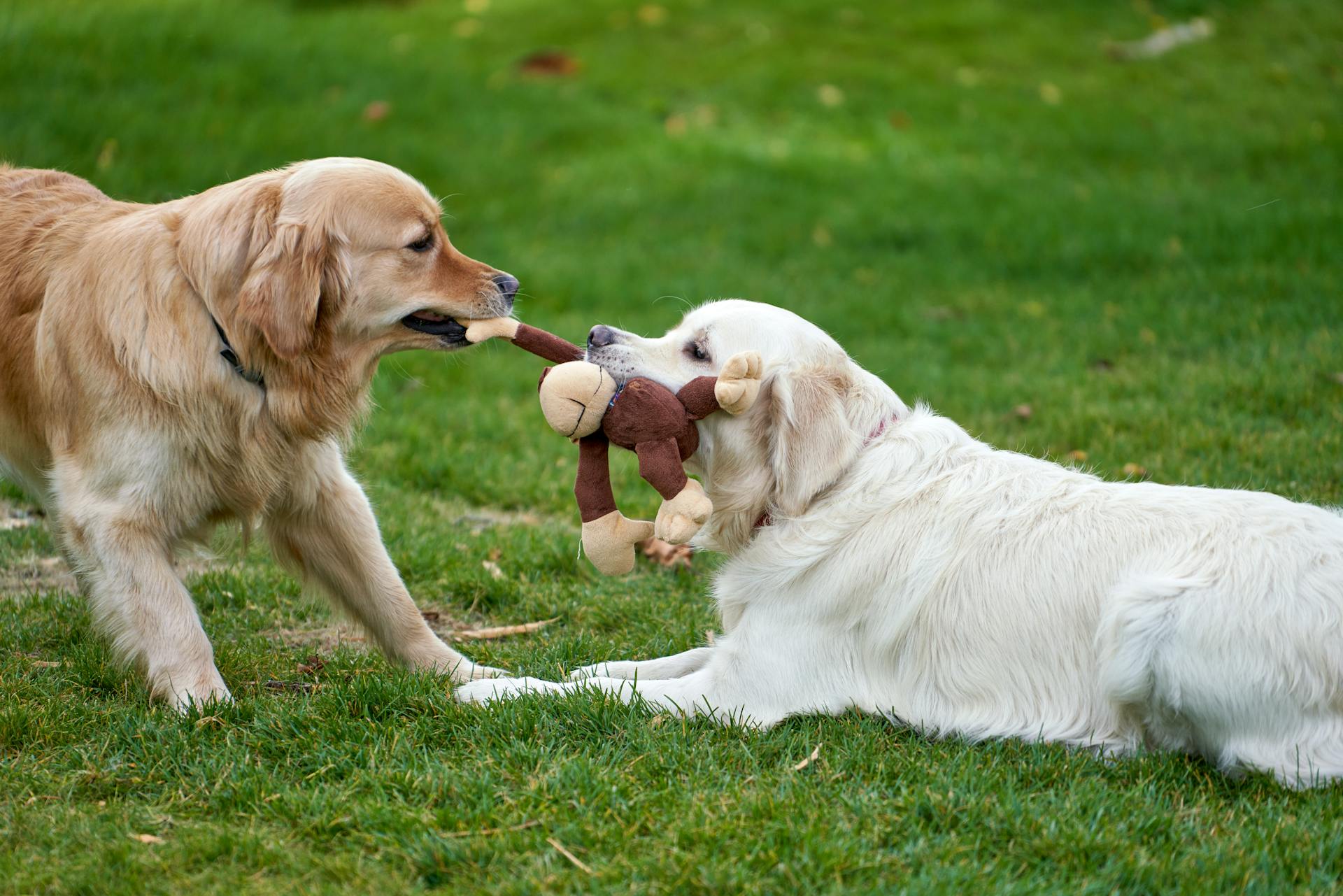
Search dogs of 911 are trained to locate missing people, survivors of natural disasters, and even human remains. These dogs are highly skilled and play a crucial role in saving lives.
Their training begins with basic obedience and socialization, followed by specialized training in search and rescue techniques. This training can last from several months to a few years, depending on the dog's age and aptitude.
Search dogs are often deployed in areas where survivors may be buried under debris or trapped in rubble. Their keen sense of smell and agility enable them to navigate through tight spaces and detect subtle scents.
You might like: Survivors Dogs Books
History of Search Dogs
The History of Search Dogs is a fascinating story that spans centuries. As early as the 17th century, St. Bernard dogs were used by monks to search for and rescue injured or lost travelers in the Swiss Alps.
The use of search dogs during wartime is a notable milestone. Official search and rescue dogs were first documented for use in WW1, when military-trained dogs located injured soldiers.
Before WW1, search and rescue efforts relied on human teams. But with the introduction of trained dogs, search and rescue operations became more efficient and effective.
The history of cadaver dogs is more recent, dating back to 1808 when an untrained dog alerted to the shed of a murder suspect. This led to the discovery of the remains of 2 missing women.
The first use of a dog trained exclusively for cadaver searches in forensic casework was in 1974 by the New York State Police. They investigated a homicide in Oneida county, which involved multiple victims buried in a large forested area.
Search Dog Selection and Training
Choosing the right dog for search and rescue work is crucial, and it's not just about selecting a breed. When selecting a dog, physical characteristics like coat length and temperature tolerance are taken into consideration, as a heavy-coated dog wouldn't be suitable for hot climates.
Good sociability and temperament are essential in a search dog, along with a strong prey drive, intelligence, endurance, agility, adaptability, courage, and curiosity. To ensure a dog has these qualities, breeders often select purebred dogs, as it allows for a clearer understanding of potential working abilities and genetic problems.
Dogs are trained to be search and rescue dogs from a young age, typically starting at 10-12 weeks old with scent games, and progressing to "hide and seek" activities as they get older. Training can last around 12-18 months, with 20 or more hours of training per week.
Dog Selection
Choosing the right dog for search-and-rescue work is crucial for its success and safety.
Purebred dogs are often chosen for this type of work because it allows for a clearer understanding of their potential working abilities and possible genetic problems.
Individual dogs are selected based on behaviors related to successful field work, which can include good sociability and temperament, a strong prey drive, intelligence, endurance, agility, adaptability to new environments, courage, and curiosity.
A unique perspective: Police Dogs at Work
Physical characteristics also play a significant role in dog selection, with temperature and terrain being important considerations. For example, a heavy-coated dog wouldn't be suitable for a hot climate, and a short-coated dog wouldn't be ideal for a colder climate.
Here are some key characteristics to look for in a search dog:
- Good sociability and temperament
- A strong prey drive
- Intelligence
- Endurance
- Agility
- Adaptability to new environments
- Courage
- Curiosity
Training
Training a search dog is a thorough and substantial process that begins when the dog is just a puppy. Training usually starts at 10-12 weeks old with "scent games" to introduce the dog to the concept of searching for scents. This is a crucial step in developing the dog's skills.
The training process involves repetitions and rewards, as animals learn through repeated actions and rewards for said actions. Consistent rewarding and marking of desired behavior is necessary to make sure the dog is performing well at each training level before advancing.
Some basic training includes socialization, obedience, and terrain exposure. Socialization involves taking the dog into public settings and exposing it to various experiences and people. Obedience is essential, as much search and rescue work is conducted when the dog is not on a leash. Terrain exposure involves exposing the dog to difficult and naturally avoided terrain, such as rubble and uneven or cracked ground.
If this caught your attention, see: What Can You Feed Dogs Other than Dog Food
A crucial component of training is the use of training aids, which can be natural or artificial scent sources. Natural aids include human flesh, human blood, soil samples, and adipocere. Artificial aids include putrescine and cadaverine, which are chemical compounds used for imprinting cadaver dogs.
Here are some common training methods used in search and rescue training:
- Socialization: Dogs are taken into public settings and are exposed to various experiences and people
- Obedience: How well a dog responds to commands is essential, as much SAR work is conducted when a dog is not on a leash
- Terrain: Exposure to difficult and naturally avoided terrain is necessary for SAR dog training
- Behaviour: Consistent rewarding and marking of desired behavior is necessary to make sure the dog is performing well at each training level before advancing
It's essential for handlers to select the training methods that work best for their dog, while ensuring they follow the three main principles of patience, perseverance, and praise.
Search Dog Breeds
Labrador Retrievers are a popular choice for search and rescue work, as seen with Coby and Guinness, who assisted at the World Trade Center.
They are often preferred because they have a strong prey drive, intelligence, and endurance, making them well-suited for long hours of work.
Their good sociability and temperament also make them a great fit for working with rescue teams.
German Shepherds, Labrador Retrievers, Border Collies, and Golden Retrievers are common breeds used for search-and-rescue work.
Suggestion: What Is a Work Dog
These breeds are often chosen for their physical characteristics, such as coat type, which is important for adapting to different environments.
For example, a heavy-coated dog wouldn't be suitable for hot climates, and a short-coated dog wouldn't be suitable for cold climates.
Here are some key characteristics of search dog breeds:
Honoring 9/11 Victims and Heroes
On the 20th anniversary of 9/11, it's essential to honor the memories of the people tragically taken from us that day, along with the heroic dogs who played a crucial role in the rescue efforts.
These heroic dogs were examples of the best canines around, working hand in hand with their owners and trainers to save lives and contribute to the rescue efforts.
Their actions not only saved lives but also provided comfort and hope to rescue workers and survivors alike, serving as a poignant reminder of the indomitable spirit of courage and selflessness.
The stories of these heroic dogs serve as testaments to the unbreakable bond between humans and their animal companions, a bond that has the power to uplift even in the darkest hours.
The sacrifices made by these dogs, and their human counterparts, are a solemn part of our history that reminds us of the resilience, unity, and compassion that define us as a nation.
These dogs may have been 'just doing their job,' but their impact reached far beyond their responsibilities, bringing a sliver of hope in a time of overwhelming despair.
If this caught your attention, see: Dog Sledding in the Us
Frequently Asked Questions
Are there any 9/11 rescue dogs still alive?
Unfortunately, there are no longer any 9/11 rescue dogs still alive, as the last known survivor, Bretagne, passed away in 2016. However, her legacy lives on through ongoing research and evaluations of rescue dogs from that time, led by Otto.
Who was the golden retriever in 9 11?
Bretagne, a Golden Retriever rescue dog, was the first canine to search for survivors at Ground Zero after the 9/11 attacks. She worked alongside her owner and trainer, Denise Corliss, for 10 days.
Were the search and rescue dogs depressed at 9 11?
Were the search and rescue dogs at 9/11 depressed? Yes, it's highly likely that both dogs and their handlers experienced depression due to the traumatic nature of their work.
How many dogs were involved in 9/11?
Approximately 300 dogs participated in search, rescue, and recovery efforts at Ground Zero. Their bravery and skills played a crucial role in the aftermath of the 9/11 tragedy
Sources
- https://www.metropaws.com/blogs/mp-blog/remembering-the-dogs-of-9-11
- https://en.wikipedia.org/wiki/Search_and_rescue_dog
- https://www.army.mil/article/44654/army_using_search_and_rescue_dogs_to_sniff_out_survivors
- https://www.sanmateoveter.com/services/dogs/blog/hero-k-9s-september-11th
- https://outwardhound.com/furtropolis/dogs/9-11-dogs
Featured Images: pexels.com


